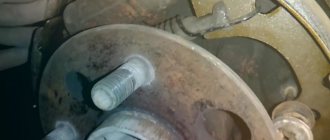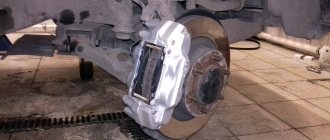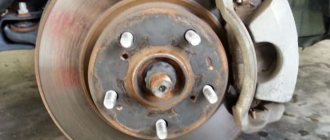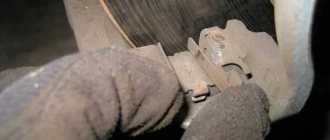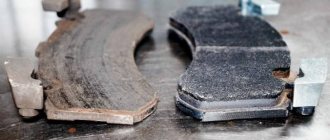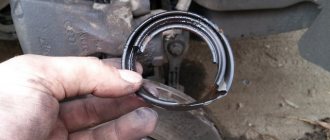Items you will need
- Wheel chocks
- Wrench
- Brake replacement
- Iron tires
- Paul Jack
- Jack is standing
- C-clamp
- Pliers (optional)
- Rubber hammer (optional)
- Silicone Grease
- Replacing brake pad springs
- Socket wrench and adapters
Knowing how to change brake rotors on a Toyota Corolla is a moderately difficult task for do-it-yourself auto mechanics. However, if you have already replaced your brake pads, this should be a relatively easy fix. Performing your own maintenance not only saves you your hard-earned money, but it also increases your ability to care for and troubleshoot your own vehicle. If you're replacing your rotors, it also makes sense to change your brake pads, unless they are relatively new. It is often recommended to replace rotors and brake pads at the same time.
Park the car on a level surface. If you are replacing all four rotors and brake pads, you will need two sets of jacks. However, if you are only doing the front or rear, it is recommended to place wooden blocks behind the wheels that will remain on the ground to prevent any rollback when working on the Corolla. Typically, brake pads and rotors wear out faster at the front than at the rear.
Place a jack under the Corolla frame about 6 inches from the tire. Raise the driver's side of the Corolla using a jack, making sure the front wheel is lifted off the ground at least 4 inches or more. Secure the vehicle by inserting a stand under the frame. Slowly release the jack and repeat the same procedure on the passenger side of the vehicle. Before proceeding, make sure the jack stands are centered under the frame and level with the ground.
Remove both wheels using a socket wrench. Set the lug nuts aside, face up, to prevent them from getting caught inside.
Remove the brake caliper mounting bolts located behind the wheel hub. Remove the brake pads and shims from the caliper after removing it.
Use a C-clamp to push the caliper piston back into the caliper body to make room for reinstalling the brake pads into the caliper. If the C-clamp is not working, you may need a pair of needle nose pliers to turn the piston clockwise and retract it into the caliper body. Different caliper designs will have different pistons. Since the Corolla has been produced for several years, different designs will be used depending on the specific model year.
Using a socket wrench or torque wrench, remove the brake caliper mounting bolts. This will give you access to the rotors.
Remove the retaining screw from the rotor disc mounting hole. This is the last part that needs to be removed before replacing the rotor. Remove the rotor from the wheel hub. If it is stuck, you may need to gently tap it with a hammer to free it from any rust between the rotor and bearing hub.
Hold the rotor with both hands and carefully move it along the wheel until it secures to the bearing hub. Screw in the fixing screw. Screw the brake caliper mount into place.
Install the new brake pad back into the caliper assembly. If the pads don't fit because the caliper piston is sticking out too much, you may need to press it into place using a C-clamp. Use a torque wrench set between 16 and 23 feet to secure the caliper assembly back to the mounting bracket.
Screw the wheels into place and carefully lower the car. You will need to bleed the brakes, also called bleeding the brakes, a couple of times to ensure that the brake fluid reaches the brake system.
Design features of the brake system
The Corolla has disc brakes on all four wheels, so replacing Toyota Corolla brake pads on the front and rear axles is not much different and not particularly difficult. However, some features should still be taken into account when replacing these parts.
In order to change the pads on the Corolla in accordance with the manufacturer’s recommendations, you should not select this part yourself. Brake pads offered by manufacturers vary in shape and thickness, attachment points, and the presence or absence of electronic wear sensors. The pads differ depending on the engine size, as well as the mounting method. Different bases are used in production. For example, they could be:
- organic;
- ceramic;
- metallic (semi-metallic).
How can you tell if a part is worn out or not?
When the time comes to replace a part, this can be understood by the presence of characteristic signs while driving:
- Wheel runout;
- A car leaving a straight path during light or emergency braking;
- Extraneous knocking and grinding noises during braking.
Car manufacturer Toyota recommends that motorists install new discs after changing the pads for the second time. However, not everyone adheres to this. Before rushing out and changing them, you should measure them. The manufacturer also determined that the minimum thickness for the front should be 23 millimeters, and for the rear 8 millimeters. Based on your measurements and the permitted parameters presented above, you should independently draw a conclusion about whether they need to be changed at all.
When to replace
Replacement is carried out as wear occurs: if the thickness of the lining has reached 2–3 mm or, in some cases, 5 mm. If this indicator decreases even more, then it is worth replacing worn parts. When worn, brake fluid consumption increases, but braking efficiency decreases.
Manufacturers of pads set the maximum possible service life, which is 40–60 thousand kilometers. But you should understand that wear depends on factors such as driving style, type of road surface, frequency of use of the car and even climatic conditions.
What signs can be used to determine the need to replace brake pads?
As already mentioned, it is better to replace it before signs of malfunction appear. However, if for one reason or another this is not possible, the driver needs to pay attention to the following “symptoms”:
- Modern Toyota models are equipped with sensors that are triggered when the friction lining reaches the permissible thickness;
- The braking distance of a vehicle has increased significantly compared to the original indicators;
- When inspecting the front pads, the car owner or car service representatives observe the appearance of abrasions and cracks on them;
- The thickness of the friction lining has decreased significantly and is up to two millimeters;
- Due to wear, the pads require a larger volume of brake fluid, which causes increased consumption;
- Braking requires the driver to exert more physical effort than usual.
Let's sum it up
Replacing Toyota Corolla E120 pads is a process accessible to most car enthusiasts. It must be carried out extremely accurately and carefully. After all, every loose bolt can lead to fatal consequences. After you have changed the brake pads on a Toyota Corolla E120, you must take into account that the replaced parts need to be broken in. Therefore, for the first 200–300 kilometers after installing new parts, you should adhere to a soft and measured driving style, try to avoid sharp, and even more so emergency braking. You should not save on your purchase; it is also important to pay attention to the thickness of the metal. The more expensive the spare parts, the higher their wear resistance. You should not buy used products.
About replacement: step-by-step instructions
To carry out the work we will need tools, namely:
- Jack;
- A set of keys;
- Balloon wrench;
- Thrust shoe;
- Wire;
- Special lubricant.
Having found out an approximate set of tools, we now proceed directly to replacing the disk. We put shoes under the wheels to prevent the car from rolling away. Next you need to unscrew the wheel. To do this, lightly remove the wheel mounting bolts with a wheel wrench. Having done this, jack up the car and completely remove the wheel. Let's look at the photos in progress.
We change Toyota Corolla brake discs. Step-by-step instructions, with recommendations from experts
Toyota Corolla cars produced between 2000 and 2008 received the greatest popularity among all models of the Japanese manufacturer.
This is explained by the fact that despite the low price, this model is very reliable, it has good driving performance, a comfortable interior, and is also well equipped in terms of safety.
But sooner or later, like in any other car, it is necessary to replace some parts, as they wear out over time. This is especially true for the chassis, namely, Toyota Corolla brake discs, pads, and stabilizer struts most often need to be replaced.
Therefore, it is advisable to know how to replace these elements of the chassis, especially since changing them is not difficult. In this article we will look in more detail at what brake discs are and how to replace them.
Checking the condition of the vehicle brake system
Replacing a brake disc on a Toyota Corolla
- a last resort. It is used in cases of complete capitulation of braking devices: if the width of the consumable is less than prescribed or when the mechanism is overheated or misbehaved. In the first case, the resource is exhausted; in the second, there is a physical breakdown, after which further use is simply dangerous.
Monitoring the condition of vehicle brakes will help identify faulty brake mechanisms and promptly replace worn out or failed parts.
It is not difficult to identify a faulty braking system. Carefully monitor your vehicle's braking performance. Has your stopping distance started to increase? Does even slight braking cause the steering wheel to vibrate? System diagnostics required.
You can measure the thickness of the brake disc yourself. This is done using a caliper. Check with the part manufacturer for the minimum thickness. If the measurement shows a value below the acceptable value, feel free to change the mechanism.
Rules for operating the brake system. How to extend the life of stopping mechanisms.
Replacing brake discs on a Toyota Corolla was successful
. But how to extend their service life?
In order for vehicle brakes to last longer, you need to know the rules for using them. The most important thing is control! If you find a malfunction, you are warned!
Monitor the brake fluid level. The norm is the maximum level. If the level drops, add fluid every 8-10 thousand km. A frequent drop in level indicates pad wear. Complete replacement - every 50 thousand km.
Smooth, timely braking is the key to the longevity of system components. Abrupt stops of vehicles shorten the service life of parts.
Check the condition of the front brake units every 10 thousand km (more often).
These minimum requirements will significantly extend the life of the parts.
Work order
To change disks you need:
- pump out liquid from the expansion tank,
- hang the car on a lift, remove the wheel;
- unscrew two bolts,
- move to the side and fix the caliper;
- remove the old “pancake”;
- clean and lubricate the mating surfaces;
- assemble the mechanism in reverse order;
- attach the wheel, lower the car;
- press the pedal several times;
- restore the normal level of brake fluid.
Replacing rear discs has some differences from the operation performed on the front axle:
- the piston of the wheel cylinder should be simultaneously pressed in and turned with a special wrench,
- after assembly, it may be necessary to adjust the handbrake drive (with the handle raised 4-5 clicks, the machine should be securely held on a 25 percent slope).
Try to avoid heavy braking while running in new consumables (the first 100 km).
Spare parts
When choosing consumables, we advise you to give preference to original spare parts or their high-quality analogues:
Parts mounted on the same axis are changed simultaneously. Otherwise, the force when stopping will be distributed unevenly, and the car will become prone to skidding or drifting.
Along the way, it is advisable to install a new set of pads, check the condition of the guides, hoses, protective covers and sealing collars, as well as the mobility of the pistons of each wheel mechanism.
Features of changing the rear discs of the Toyota Corolla brake system
This procedure is similar to that described above, with the exception of some points. Here they are:
- Release the handbrake.
- Before dismantling the disc, bring the handbrake pads together with a screwdriver.
- After replacing the pads, first spread them until there is no rotation, and then close them a little until they rotate freely.
After carrying out the work, it is necessary to fill in new fluid and bleed the hydraulic system. And remember, brakes need to be given special attention and kept in working order throughout their entire service life.
Source autoclub.su
Toyota cars have long been considered the undisputed leaders in sales in the markets. Directly, the Toyota Corolla is even listed in the Guinness Book of Records as the best-selling car in the world. Toyota Corolla, despite the huge competition, has practically no analogues. Few cars can boast the same excellent ratio of price, quality, wear resistance of parts and, most importantly, safety.
But, unfortunately, even such cars require maintenance and repair, especially if your car has already crossed the line of 10 years of operation. What you should especially pay attention to are the brakes. And we're not just talking about Toyota cars. Good brakes mean excellent safety, or a saved pedestrian. This article will focus on a more in-depth inspection of brake discs and pads.

